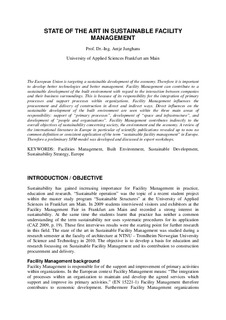State of the art in sustainable Facility Management
Chapter
Submitted version
Permanent lenke
http://hdl.handle.net/11250/2391048Utgivelsesdato
2011Metadata
Vis full innførselSamlinger
Originalversjon
Haugbølle, K., Gottlieb, S. C., Kähkönen, K. E., Klakegg, O. J., Lindahl, G. A., & Widén, K. (Eds.) (2011).Proceedings of the 6th Nordic Conference on Construction Economics and Organisation: Shaping the Construction/Society Nexus. Volume 2: Transforming PracticesSammendrag
The European Union is targeting a sustainable development of the economy. Therefore it is important to develop better technologies and better management. Facility Management can contribute to a sustainable development of the built environment with regard to the interaction between companies and their business surroundings. This is because of its responsibility for the integration of primary processes and support processes within organizations. Facility Management influences the procurement and delivery of construction in direct and indirect ways. Direct influences on the sustainable development of the built environment are seen within the three main areas of responsibility: support of “primary processes”, development of “space and infrastructure”, and development of “people and organisations”. Facility Management contributes indirectly to the overall objectives of sustainability concerning society, the environment and the economy. A review of the international literature in Europe in particular of scientific publications revealed up to now no common definition or consistent application of the term “sustainable facility management” in Europe. Therefore a preliminary SFM-model was developed and discussed in expert workshops.
